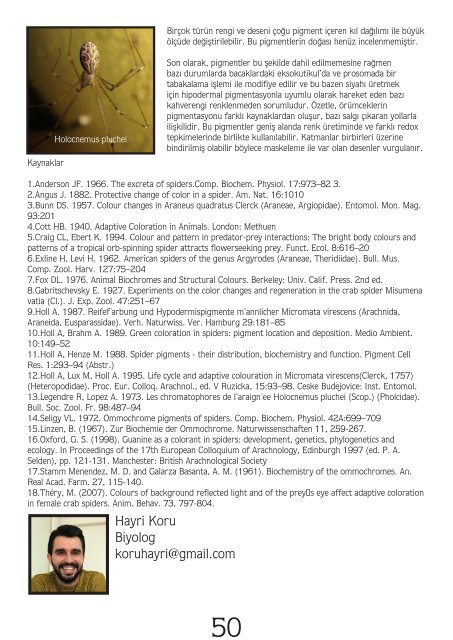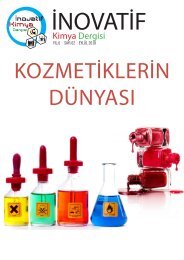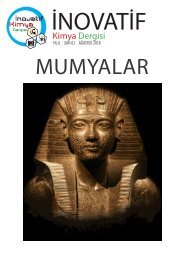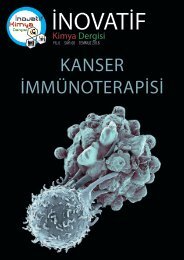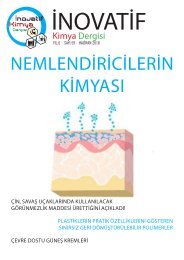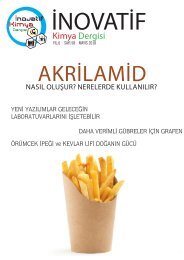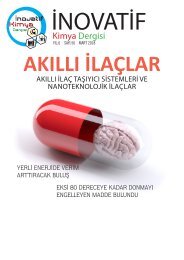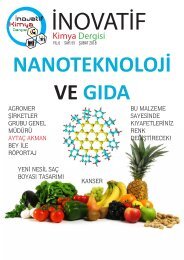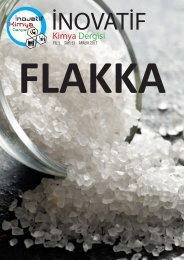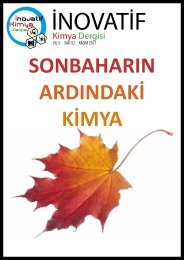Inovatif Kimya Dergisi Sayi 54
İnovatif Kimya Dergisi Sayi 54
İnovatif Kimya Dergisi Sayi 54
Create successful ePaper yourself
Turn your PDF publications into a flip-book with our unique Google optimized e-Paper software.
50<br />
Birçok türün rengi ve deseni çoğu pigment içeren kıl dağılımı ile büyük<br />
ölçüde değiştirilebilir. Bu pigmentlerin doğası henüz incelenmemiştir.<br />
Kaynaklar<br />
Holocnemus pluchei<br />
Son olarak, pigmentler bu şekilde dahil edilmemesine rağmen<br />
bazı durumlarda bacaklardaki eksokutikul’da ve prosomada bir<br />
tabakalama işlemi ile modifiye edilir ve bu bazen siyahı üretmek<br />
için hipodermal pigmentasyonla uyumlu olarak hareket eden bazı<br />
kahverengi renklenmeden sorumludur. Özetle, örümceklerin<br />
pigmentasyonu farklı kaynaklardan oluşur, bazı salgı çıkaran yollarla<br />
ilişkilidir. Bu pigmentler geniş alanda renk üretiminde ve farklı redox<br />
tepkimelerinde birlikte kullanılabilir. Katmanlar birbirleri üzerine<br />
bindirilmiş olabilir böylece maskeleme ile var olan desenler vurgulanır.<br />
1.Anderson JF. 1966. The excreta of spiders.Comp. Biochem. Physiol. 17:973–82 3.<br />
2.Angus J. 1882. Protective change of color in a spider. Am. Nat. 16:1010<br />
3.Bunn DS. 1957. Colour changes in Araneus quadratus Clerck (Araneae, Argiopidae). Entomol. Mon. Mag.<br />
93:201<br />
4.Cott HB. 1940. Adaptive Coloration in Animals. London: Methuen<br />
5.Craig CL, Ebert K. 1994. Colour and pattern in predator-prey interactions: The bright body colours and<br />
patterns of a tropical orb-spinning spider attracts flowerseeking prey. Funct. Ecol. 8:616–20<br />
6.Exline H, Levi H. 1962. American spiders of the genus Argyrodes (Araneae, Theridiidae). Bull. Mus.<br />
Comp. Zool. Harv. 127:75–204<br />
7.Fox DL. 1976. Animal Biochromes and Structural Colours. Berkeley: Univ. Calif. Press. 2nd ed.<br />
8.Gabritschevsky E. 1927. Experiments on the color changes and regeneration in the crab spider Misumena<br />
vatia (Cl.). J. Exp. Zool. 47:251–67<br />
9.Holl A. 1987. Reifef¨arbung und Hypodermispigmente m¨annlicher Micromata virescens (Arachnida,<br />
Araneida, Eusparassidae). Verh. Naturwiss. Ver. Hamburg 29:181–85<br />
10.Holl A, Brahm A. 1989. Green coloration in spiders: pigment location and deposition. Medio Ambient.<br />
10:149–52<br />
11.Holl A, Henze M. 1988. Spider pigments - their distribution, biochemistry and function. Pigment Cell<br />
Res. 1:293–94 (Abstr.)<br />
12.Holl A, Lux M, Holl A. 1995. Life cycle and adaptive colouration in Micromata virescens(Clerck, 1757)<br />
(Heteropodidae). Proc. Eur. Colloq. Arachnol., ed. V Ruzicka, 15:93–98. Ceske Budejovice: Inst. Entomol.<br />
13.Legendre R, Lopez A. 1973. Les chromatophores de l’araign´ee Holocnemus pluchei (Scop.) (Pholcidae).<br />
Bull. Soc. Zool. Fr. 98:487–94<br />
14.Seligy VL. 1972. Ommochrome pigments of spiders. Comp. Biochem. Physiol. 42A:699–709<br />
15.Linzen, B. (1967). Zur Biochemie der Ommochrome. Naturwissenschaften 11, 259-267.<br />
16.Oxford, G. S. (1998). Guanine as a colorant in spiders: development, genetics, phylogenetics and<br />
ecology. In Proceedings of the 17th European Colloquium of Arachnology, Edinburgh 1997 (ed. P. A.<br />
Selden), pp. 121-131. Manchester: British Arachnological Society<br />
17.Stamm Menendez, M. D. and Galarza Basanta, A. M. (1961). Biochemistry of the ommochromes. An.<br />
Real Acad. Farm. 27, 115-140.<br />
18.Théry, M. (2007). Colours of background reflected light and of the preyʼs eye affect adaptive coloration<br />
in female crab spiders. Anim. Behav. 73, 797-804.<br />
Hayri Koru<br />
Biyolog<br />
koruhayri@gmail.com


